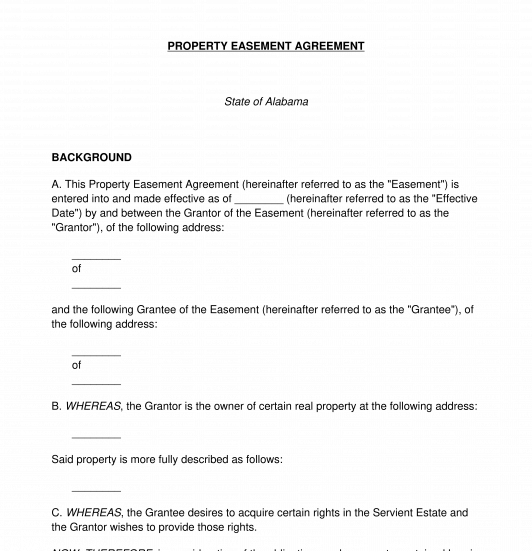 09/30/2025
09/30/2025

Answer a few questions and your document is created automatically.

Your document is ready! You will receive it in Word and PDF formats. You will be able to modify it.




Rating: 4.6 - 75 votes
Download a basic template (FREE) Create a customized documentA Property Easement Agreement is a document used by the owner of a property, known as a grantor, to give permission for another person, known as the grantee, to use that property, often for a limited or specific purpose. This document is an easy way to grant temporary or long-term access to land without transferring ownership entirely. For example, if neighbors share a driveway but access to the main road is only possible through a portion of the driveway owned by one of the neighbors, they could create an easement to give their neighbor limited permission to use their portion of the driveway to access the road.
This document can create two different types of easements, depending on the circumstances:
A Property Easement Agreement creates clear and precise boundaries and specifies the purpose for the easement and any limitations to how it can be used. This is crucial to avoid any future miscommunication or dispute, especially since easements are often put in place for a long time and can last long enough that the parties no longer remember the original terms of their agreement. This document works for all types of properties, whether they are rural or urban, commercial or residential, as long as the person granting the easement is the owner of the property.
How to use this document
This document includes all of the information necessary to create a thorough and comprehensive Property Easement Agreement. This Agreement can be created by either the grantor or the grantee but its terms must be agreed to and signed by both parties. The document includes various options to tailor the Agreement to meet the parties' needs. The Agreement allows the Parties to specify the following important details that will guide their grantor/grantee relationship:
After inputting the required information, the Agreement is printed out and signed by both Parties, and then kept on file by both Parties for the duration of the Agreement as well as for a reasonable period of time thereafter. The completed agreement should be filed according to local rules which are different from county to county. For example, in Philadelphia, an easement should be filed with the city clerk of courts in the recorder of deeds department. Contact the local county Register of Deeds to get information about which government agency should be given the easement to file and record before being returned to the parties.
Applicable law
Easement Agreements are governed by state law. Different states have different requirements for whether and how the easement should be filed.
How to modify the template
You fill out a form. The document is created before your eyes as you respond to the questions.
At the end, you receive it in Word and PDF formats. You can modify it and reuse it.
Property Easement Agreement - FREE - Sample, template
Country: United States